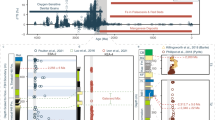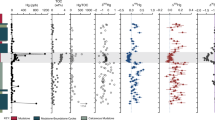Abstract
Understanding the composition of the atmosphere over geological time is critical to understanding the history of the Earth system, as the atmosphere is closely linked to the lithosphere, hydrosphere and biosphere. Although much of the history of the lithosphere and hydrosphere is contained in rock and mineral records, corresponding information about the atmosphere is scarce and elusive owing to the lack of direct records. Geologists have used sedimentary minerals, fossils and geochemical models to place constraints on the concentrations of carbon dioxide, oxygen or methane in the past1,2,3,4. Here we show that the triple oxygen isotope composition of sulphate from ancient evaporites and barites shows variable negative oxygen-17 isotope anomalies over the past 750 million years. We propose that these anomalies track those of atmospheric oxygen and in turn reflect the partial pressure of carbon dioxide ( ) in the past through a photochemical reaction network linking stratospheric ozone to carbon dioxide and to oxygen5,6. Our results suggest that
) in the past through a photochemical reaction network linking stratospheric ozone to carbon dioxide and to oxygen5,6. Our results suggest that  was much higher in the early Cambrian than in younger eras, agreeing with previous modelling results2. We also find that the 17O isotope anomalies of barites from Marinoan (∼635 million years ago) cap carbonates display a distinct negative spike (around -0.70‰), suggesting that by the time barite was precipitating in the immediate aftermath of a Neoproterozoic global glaciation, the
was much higher in the early Cambrian than in younger eras, agreeing with previous modelling results2. We also find that the 17O isotope anomalies of barites from Marinoan (∼635 million years ago) cap carbonates display a distinct negative spike (around -0.70‰), suggesting that by the time barite was precipitating in the immediate aftermath of a Neoproterozoic global glaciation, the  was at its highest level in the past 750 million years. Our finding is consistent with the ‘snowball Earth’ hypothesis7,8 and/or a massive methane release9 after the Marinoan glaciation.
was at its highest level in the past 750 million years. Our finding is consistent with the ‘snowball Earth’ hypothesis7,8 and/or a massive methane release9 after the Marinoan glaciation.
This is a preview of subscription content, access via your institution
Access options
Subscribe to this journal
Receive 51 print issues and online access
$199.00 per year
only $3.90 per issue
Buy this article
- Purchase on Springer Link
- Instant access to full article PDF
Prices may be subject to local taxes which are calculated during checkout



Similar content being viewed by others
References
Rye, R., Kuo, P. H. & Holland, H. D. Atmospheric carbon dioxide concentrations before 2.2 billion years ago. Nature 378, 603–605 (1995)
Berner, R. A. GEOCARBSULF: A combined model for Phanerozoic atmospheric O2 and CO2 . Geochim. Cosmochim. Acta 70, 5653–5664 (2006)
Ekart, D. D., Cerling, T. E., Montanez, I. P. & Tabor, N. J. A 400 million year carbon isotope record of pedogenic carbonate: implications for paleoatmospheric carbon dioxide. Am. J. Sci. 299, 805–827 (1999)
Royer, D. L. et al. Paleobotanical evidence for near present-day levels of atmospheric CO2 during part of the Tertiary. Science 292, 2310–2313 (2001)
Yung, Y. L., DeMore, W. B. & Pinto, J. P. Isotopic exchange between carbon dioxide and ozone via O(1D) in the stratosphere. Geophys. Res. Lett. 18, 13–16 (1991)
Yung, Y. L. et al. Carbon dioxide in the atmosphere: Isotopic exchange with ozone and its use as a tracer in the middle atmosphere. J. Geophys. Res. 102 (D9). 10857–10866 (1997)
Hoffman, P. F., Kaufman, A. J., Halverson, G. P. & Schrag, D. P. A Neoproterozoic snowball Earth. Science 281, 1342–1346 (1998)
Pierrehumbert, R. T. High levels of atmospheric carbon dioxide necessary for the termination of global glaciation. Nature 429, 646–649 (2004)
Jiang, G. Q., Kennedy, M. J. & Christie-Blick, N. Stable isotopic evidence for methane seeps in Neoproterozoic postglacial cap carbonates. Nature 426, 822–826 (2003)
Bao, H. M. et al. Anomalous 17O compositions in massive sulphate deposits on the Earth. Nature 406, 176–178 (2000)
Bao, H. M., Thiemens, M. H., Loope, D. B. & Yuan, X. L. Sulfate oxygen-17 anomaly in an Oligocene ash bed in mid-North America: Was it the dry fogs? Geophys. Res. Lett. 30 (16). 1843 1810.1029/2003GL016869 (2003)
Howell, K. J. & Bao, H. M. Caliche as a geological repository for atmospheric sulfate. Geophys. Res. Lett. 33 L13816 10.1029/2006GL026518 (2006)
Alexander, B. et al. Climate driven changes in the oxidation pathways of atmospheric sulfur. Geophys. Res. Lett. 29 (14). 1685 10.1029/2002GL014879 (2002)
Bao, H. M. & Marchant, D. R. Quantifying sulfate components and their variations in soils of the McMurdo Dry Valleys, Antarctica. J. Geophys. Res. 111 (D16301). 10.1029/2005JD006669 (2006)
Savarino, J., Lee, C. C. W. & Thiemens, M. H. Laboratory oxygen isotopic study of sulfur (IV) oxidation: Origin of the mass-independent oxygen isotopic anomaly in atmospheric sulfates and sulfate mineral deposits on Earth. J. Geophys. Res. 105 (D23). 29079–29088 (2000)
Bao, H. M. Sulfate in modern playa settings and in ash beds in hyperarid deserts: Implication on the origin of 17O-anomalous sulfate in an Oligocene ash bed. Chem. Geol. 214, 127–134 (2005)
van Stempvoort, D. R. & Krouse, H. R. in Environmental Geochemistry of Sulfide Oxidation Vol. 550 (eds Alpers, C. N. & Blowes, D. W.) 446–480 (American Chemical Society, Washington DC, 1994)
Balci, N., Shanks, W. C., Mayer, B. & Mandernack, K. W. Oxygen and sulfur isotope systematics of sulfate produced by bacterial and abiotic oxidation of pyrite. Geochim. Cosmochim. Acta 71, 3796–3811 (2007)
Bender, M., Sowers, T. & Labeyrie, L. The Dole effect and its variations during the last 130,000 years as measured in the Vostok ice core. Glob. Biogeochem. Cycles 8, 363–376 (1994)
Luz, B. et al. Triple-isotope composition of atmospheric oxygen as a tracer of biosphere productivity. Nature 400, 547–550 (1999)
Young, E. D., Galy, A. & Nagahara, H. Kinetic and equilibrium mass-dependent isotope fractionation laws in nature and their geochemical and cosmochemical significance. Geochim. Cosmochim. Acta 66, 1095–1104 (2002)
Miller, M. F. Isotopic fractionation and the quantification of 17O anomalies in the oxygen three-isotope system: an appraisal and geochemical significance. Geochim. Cosmochim. Acta 66, 1881–1889 (2002)
Luz, B. & Barkan, E. The isotopic ratios 17O/16O and 18O/16O in molecular oxygen and their significance in biogeochemistry. Geochim. Cosmochim. Acta 69, 1099–1110 (2005)
Blunier, T., Barnett, B., Bender, M. L. & Hendricks, M. B. Biological oxygen productivity during the last 60,000 years from triple oxygen isotope measurements. Glob. Biogeochem. Cycles 16 (3). 1029 10.1029/2001GB001460 (2002)
Gamsjäger, H. & Murmann, R. K. in Advances in Inorganic and Bioinorganic Mechanisms Vol. 2 (ed. Sykes, A. G.) 317–381 (Academic, London, 1983)
Jiang, G. Q. et al. Stratigraphy, sedimentary structures, and textures of the late Neoproterozoic Doushantuo cap carbonate in South China. J. Sediment. Res. 76, 978–995 (2006)
Kasemann, S. A. et al. Boron and calcium isotope composition in Neoproterozoic carbonate rocks from Namibia: evidence for extreme environmental change. Earth Planet. Sci. Lett. 231, 73–86 (2005)
Bao, H. M. Purifying synthetic barite for oxygen isotope measurement by dissolution and reprecipitation in a chelating solution. Anal. Chem. 78, 304–309 (2006)
Bao, H. M. & Thiemens, M. H. Generation of O2 from BaSO4 using a CO2-laser fluorination system for simultaneous analysis of δ18O and δ17O. Anal. Chem. 72, 4029–4032 (2000)
Mauersberger, K., Krankowsky, D., Janssen, C. & Schinke, R. in Advances in Atomic, Molecular, and Optical Physics Vol. 50 1–54 (Elsevier Academic, San Diego, 2005)
Acknowledgements
We thank numerous colleagues who have contributed evaporite and barite samples over the years, including W. T. Holser, M. Tucker, C. Spötl, R. Denison, C. Laughrey, S. C. Morris, S. P. Das Gupta, K. Benison, B.–H. Fu, S. Xiao, G. Retallack, W.-L. Zang, J. Hanor, B. Ellwood, D. Henry, B. Dutrow and A. J. Kaufman. One important barite sample, collected by G. P. Halverson, P. F. Hoffman and A. C. Maloof in Mauritania, West Africa, was obtained from M. H. Thiemens and D. P. Schrag. We thank Huifeng Bao for field assistance, M. Khachaturyan for laboratory assistance, and NSF, LSU, NASA (Planetary Atmospheres), the NNSF of China, the Chinese Academy of Sciences and the Chinese Ministry of Science and Technology for financial support.
Author Contributions H.B. designed the research, developed analytical procedures and performed measurements. J.R.L. did one-dimensional photochemical modelling and C.M.Z. directed fieldwork in South China. H.B. and J.R.L. wrote the manuscript.
Author information
Authors and Affiliations
Corresponding author
Supplementary information
Supplementary information
The file contains Supplementary Data with Supplementary Tables S1-S2, Supplementary Figures S1-S5 and additional references. (PDF 1180 kb)
Rights and permissions
About this article
Cite this article
Bao, H., Lyons, J. & Zhou, C. Triple oxygen isotope evidence for elevated CO2 levels after a Neoproterozoic glaciation. Nature 453, 504–506 (2008). https://doi.org/10.1038/nature06959
Received:
Accepted:
Issue Date:
DOI: https://doi.org/10.1038/nature06959
This article is cited by
-
Sulfate triple-oxygen-isotope evidence confirming oceanic oxygenation 570 million years ago
Nature Communications (2023)
-
Zinc, carbon, and oxygen isotopic variations associated with the Marinoan deglaciation
Mineralogy and Petrology (2023)
-
Snowfall-albedo feedbacks could have led to deglaciation of snowball Earth starting from mid-latitudes
Communications Earth & Environment (2021)
-
The Isotopic Imprint of Life on an Evolving Planet
Space Science Reviews (2020)
-
Transient marine euxinia at the end of the terminal Cryogenian glaciation
Nature Communications (2018)
Comments
By submitting a comment you agree to abide by our Terms and Community Guidelines. If you find something abusive or that does not comply with our terms or guidelines please flag it as inappropriate.



